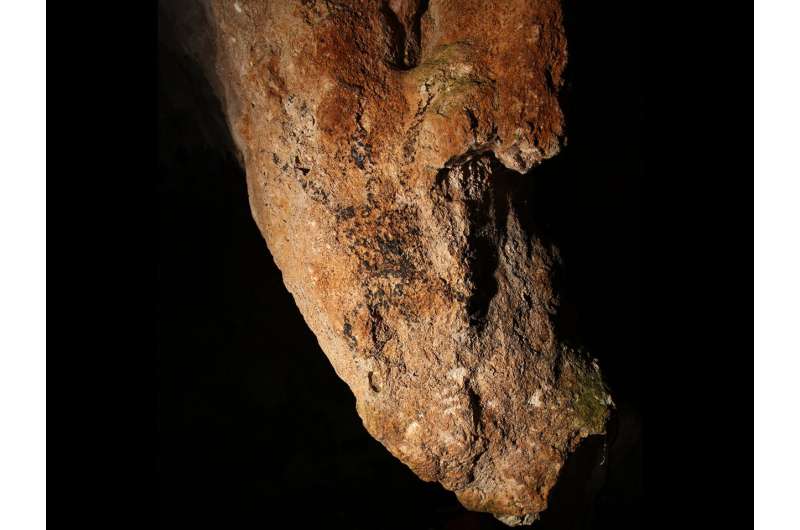Philippines cave art becomes first directly dated in Southeast Asia

A Griffith University-led research team has carbon-dated cave art resembling a human-like figure in the Philippines for the first time, potentially clarifying the timeline of early human activity in the area.
Discovered in one of the Peñablanca caves, a region where the oldest human remains in the Philippines were found, the figure has been directly dated as about 3500 years old.
Lead author Dr. Andrea Jalandoni from Griffith University's Place, Evolution and Rock Art Heritage Unit says the date offers a more holistic view of the people inhabiting the caves at that time.
"The date corresponds with archaeological activity found at other sites such as foraging activities in Eme and Arku Caves and pottery in Callao Cave.
"We now have an expansive picture of the people that inhabited the Peñablanca Caves over 3,500 years ago, they foraged for food, used pottery and created rock art."
Dr. Jalandoni said there was untapped potential for dating similar charcoal rock art figures in the Peñablanca region which may help resolve lingering questions of human migration.
"It was created by either early Austronesians, who arrived around 4000 years ago and are the dominant current population in the Philippines or the Agta Negritos who migrated during the Ice Age. Both groups still live in the area, so more rock art needs to be dated to determine its origin."
The team also reviewed black pigment cave art across Southeast Asia and found similar motifs in Malaysia and Indonesia.
Griffith University Chair in Rock Art Research Professor Paul Taçon said the results were exciting because it proves that some charcoal-based human figure rock art was made thousands of years ago during socio-cultural change across the region.
"It will now be important to date similar figures elsewhere to see if they are of the same age or if these types of human figures were made over a long period of time."
Dr. Jalandoni said the new date also challenges the preconceived notion that all black pigment rock art is recent.
"Our research shows the significance of these rock art sites and why a conservation plan is desperately needed.
"These rock art sites are fast disappearing. Our team was only able to find 94 out of 250 of the figures traced back in 1976-1977. One rock art site at Hunong Spring has been lost completely and it is concerning as a researcher."
National Museum of the Philippines Cultural Deputy for Cagayan Valley Mylene Lising said the study contributes to the developing awareness about early human groups in the Philippine Islands.
"It is a glimpse into how they interacted with their environment and what their behaviours were like 3500 years ago. It is relevant in the bigger context because it promotes a better understanding of ourselves as humans."
More information: Andrea Jalandoni et al. First Directly Dated Rock Art in Southeast Asia and the Archaeological Implications, Radiocarbon (2021). DOI: 10.1017/RDC.2021.29
Provided by Griffith University





















